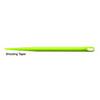The most confusing part of fly fishing, for a beginner, is the different tapers in fly line, which are all designed for different uses and situations.
For a beginner, deciphering what kind of fly line taper you are looking at can be difficult. Once you get the basics down, it is not that hard to figure out.
What is fly line taper anyway?
Tapers are adjustments to the fly line to make the line cast easier and better in different situations. Fly line will not weigh the same or have a uniform thickness throughout the length, thus, "not level". Fine adjustments are often made that either increase the weight or the width in key sections of the line. These adjustments in the fly line greatly add in casting and line control. So the type of taper in a fly line has describes the type of adjustments to the fly line to make casting easier and gives better line control. Remember, the taper is an adjustment or enhancement to the line to make it cast better with easier line control making it more effective. There are several fly line tapers available, the abbreviation for each taper is on the box. The available tapers are;
Level Taper (L)
Double Taper (DT)
Weight Forward Taper (WF)
Shooting Taper (ST)
Remember these abbreviations when buying your fly line.
LEVEL TAPER (L) this is the easiest to understand, but the least used in fly fishing. Level Taper, due to the even weight and width, float extremely well but are much more difficult to cast and control than other fly lines. It also tends to make kind of a racket when it hits the water. It is the least expensive fly line available. Beginners should stay away from level taper fly line as it is the most difficult to cast and control.
WEIGHT FORWARD (WF) is the most popular fly line as well as being the most expensive. The first 30 feet has extra weight and width built in. The remainder of the fly line will be level, of equal weight and width. With weight forward line larger flies can be used, longer and more effective casts can be made even in windy conditions. It is crucial that the line is put on the reel correctly. You want the added weight and width of the fly line to be on the end not tied to the reel. Also, if the fly line becomes cracked or damaged it cannot be reversed. Weight forward fly line is good for beginners. Long casts, better control and weight forward line is always used when casting heavy things like bass bugs or streamers.
DOUBLE TAPER (DT) has a heavier and thicker middle section and gradually looses both weight and width. The closer it gets to the end of the fly line. What is important to remember about double taper is that it is balanced, both ends of the line weigh the same and each end gradually inreases in width and weight the closer to the middle section of the fly line at an equal rate. The double taper is reversible, should the front of the line become worn out, all you need do is turn it around.
SHOOTING TAPER (ST) fly line was designed for fly casting tournaments. This can explain their function. The first 20 feet is heavily weighted, the remainder is of uniform weight and thickness, but much thinner than a traditional weight forward line. With the extra weight and width of the first 20 feet, in combination with the remaining length of thinner fly line, reduces the drag and air resistance on the fly rod guides. In the hands of an expert, greatly increases the casting distance. While great for long distance casting, shooting taper fly line lacks the delicacy needed for general all around fly fishing. Due to the weight being forward, it can make a racket when it hits the water. Since the back end of the fly line is thinner than the standard fly line, it has a nasty tendency to coil and get knotted up. To avoid this, many anglers use a stripping basket. This fly line is not recommended for a beginner.

No comments:
Post a Comment